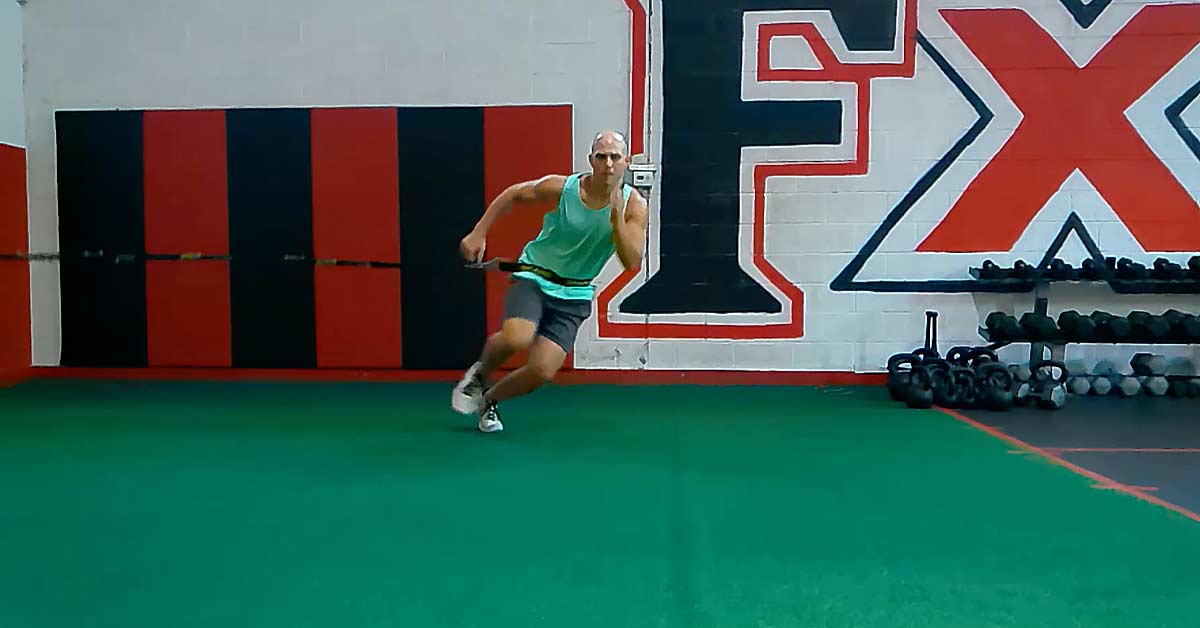Strength coaches are familiar with bands when it comes to strength development. Bands are hooked on a bar to increase tension at the top of the range of motion for a squat or bench press. They can also be used as assistance for pull-ups, as well as drills specifically targeting the hips and shoulders. For the purpose of this article, I won’t get into the use of bands for strength development; instead, I’ll go over how to use bands specifically for speed and power development.
There are other tools available for adding or removing resistance, such as the 1080 Sprint, but most coaches do not have access to that type of tool. Even if you do have one, it can be difficult to cycle groups of athletes through any one piece of equipment. Bands provide a relatively cheap and effective way to improve speed and power for individuals or groups of athletes.
Bands are great for adding resistance, but they can also be a fantastic tool for removing resistance when necessary. Share on XAny piece of training equipment is only as good as the manner in which the coach applies it. For the most part, bands are an underutilized piece of training equipment. They are great for adding resistance, but they can also be a fantastic tool for removing resistance when necessary. I always look for ways to minimize verbal cueing to get my athletes to move how I want them to move, and bands allow me to do just that. For example, if I need an athlete to create a more powerful initial push, I can have them perform a drill where they have to overcome band resistance at the outset of the movement.
[adsanity align=’aligncenter’ id=9181]
Using Bands for Speed Training
There are two main uses I have for training with bands:
- To try to teach the athlete to be quicker off the ground—this happens when an athlete is being assisted in accelerating out of a cut.
- To try to improve stability and power when the band is pulling an athlete into a change of direction.
When deciding how to progress or regress exercises, always begin with the end goal in mind. In a previous article, I spoke about the importance of unilateral power development—that is the end goal with all of my athletes. Effective change of direction happens when an athlete can plant a foot into the ground and rapidly stop and redirect force in the direction they want to move. This rapid deceleration and subsequent reacceleration only happen with a quick and powerful foot plant. I want my athletes to learn to be quick and then transfer that quickness into more and more power. This particular aspect of changing direction can be significantly improved through training with bands.
Video 1.Moving toward or away from the anchor changes the intent of the drill.
The above clip demonstrates how using band resistance can assist with change of direction, as seen in the first portion of the video. In that case, initiating the movement away from the anchor point increases band tension, which helps the athlete get in and out of the change of direction. Initiating movement toward the anchor has the opposite effect and adds more speed to the movement. This challenges the athlete’s ability to rapidly stabilize and produce force quickly.
As coaches, we should never stop looking for ways to help our athletes improve. I view every speed drill as an assessment. I need my athletes to develop quickness and then learn how to transfer that quickness into power. Easily, the number one cue I use with my athletes is “move faster.” Athletes may think they are moving fast, but there’s usually a little more they can give in terms of speed and power in training. They need to understand what it feels like to truly move fast.
That’s where a drill like a band-resisted shuffle (the first drill in video 1) is such a great movement—the athlete will shuffle away from the anchor point and immediately shuffle back to where they started. As they shuffle away from the anchor, the resistance of the band increases. This increased band resistance unweights the athlete and helps them be quicker when initiating the change of direction to shuffle back toward the start of the drill.
Now that the athlete has the feeling of being quicker, you can progress them by performing the shuffle from the opposite direction (the second drill in video 1). This is an example of the second way I like to use bands in my training. In this case, I’m accelerating an athlete toward the anchor point of the band. Accelerating into a cut forces more stability and power when getting in and out of that cut quickly.
In a drill like this, you don’t need much resistance to get the desired effect. If an athlete is able to perform the drill well by maintaining a good position and quickness off the ground, then I have them slightly increase the resistance at the start of the drill. I want my athletes on the edge of working really hard to be quick off the ground but not give them too much resistance where it looks like they get stuck in the cut.
Progressing Speed Drills with Bands
Progressing speed drills using bands is as simple as increasing the distance you cover within the drill. More tension on the band equals a greater distance to overcome if you are moving away from the anchor point. If you are moving toward the anchor point, the more stretch you have on the band, the more you will increase your acceleration toward the anchor. When performing a drill where you are continuously moving out and back, a greater acceleration toward the anchor will make the change of direction much more difficult.
Progressing speed drills using bands is as simple as increasing the distance you cover within the drill. Share on XVideo 2. Train deceleration with bands by using them to accelerate the athlete into an abrupt stop. Then progress that drill by adding in a sprint out of the change of direction.
One of the methods I like to use prior to performing a drill where an athlete moves out and back is just to have the athlete sprint toward the anchor and perform an offset stop with a high amount of acceleration from the band (the first drill in video 2). This allows the athlete to get used to handling higher amounts of force over shorter distances. If you are in a gym with minimal running space, this is a great way to simulate running at slightly higher speeds. Once the athlete performs that drill a few times, you can progress it by having them sprint toward the anchor, slam on the brakes, and sprint back out in the same direction they came from.
Getting in and out of a change of direction quickly like this requires high amounts of power, strength, and stability in this position. The bands provide a great tool for athletes to demonstrate this type of positional strength.
Video 3. Bands are an effective tool for adding or removing resistance when changing vectors.
Another reason for using bands for speed and power development is the ease at which you can change vectors while adding resistance or accelerating yourself into a cut. Most sports are not primarily linear or lateral—athletes move forward and backward at a variety of angles. Bands allow you to train these particular angles easily.
Another reason for using bands for speed and power development is the ease at which you can change vectors while adding resistance or accelerating yourself into a cut. Share on XVideo 4. Bands can be useful for training starting acceleration.
Although I have primarily focused on change-of-direction training with bands, they are also great tools for training linear speed. In most sports, athletes don’t reach top speed in competition. They often need to slow down or change direction. It’s rare to have an opportunity to run in a straight line for 40 yards without decelerating or changing course. This fact makes acceleration even more important in terms of athlete development.
I particularly like to use band-resisted three-step bursts with my athletes. Starting with a little bit of resistance encourages my athletes to stay low and create a good angle of projection. With each step, the resistance from the band increases a little bit, which continues to encourage my athletes to stay low and push hard to maintain horizontal projection.
[adsanity align=’aligncenter’ id=9056]
Using Bands for Power Development
Repeating jumps continuously, jumping with weights, and jumping off higher boxes are the most familiar ways to progress plyometrics. You can also use bands to improve your athlete’s ability to produce high amounts of force over a short period of time.
The same principles that apply to using bands with speed training can also apply to using bands for power development. You can use bands for power development in all directions by employing lateral, anterior, posterior, and vertical forms of resistance.
Video 5. This is a great drill to use at the beginning of a plyometric program. It helps develop tissue quality while allowing the athlete to take advantage of the stretch-shortening cycle.
Bands can be particularly effective for training young athletes. Progressing younger athletes from countermovement jumps to depth jumps over the course of a single off-season is not a smart progression in terms of long-term athletic development. Going right into pogo jumps can be a little too difficult for younger athletes to execute effectively because they lack the elasticity to take advantage of the stretch-shortening cycle and get off the ground quickly.
This is where band-assisted drills can be beneficial. Performing a drill like a band-assisted pogo jump is a great place to start in terms of getting athletes to develop a sense of using the stretch reflex. Drills like this are also great for larger athletes, such as American football offensive and defensive linemen. Larger athletes are known for being able to produce a lot of force, which is great, but their tendon strength may not be developed enough for jumping right into an intense plyometric training program.
A general consensus for progressing plyometric training is to either add load to the jumps or increase the eccentric force on the landing of a jump. This is often done by stepping down off a box and performing a jump vertically. While this is great for improving force vertically into the ground, it does not account for much of the horizontal nature of power in field sports.
I previously mentioned how rare it is for an athlete to run in a straight line for an extended period. Therefore, it is imperative that athletes improve their ability to develop force horizontally in all directions. Effective change of direction happens when an athlete plants their foot into the ground away from their center of mass. By doing this, the athlete creates a better angle for projecting out of a cut. Striking closer to their center of mass will lead to a more vertical shin angle and less effective acceleration.
Video 6. A drill like this is effective for mimicking the higher speeds an athlete may have when getting in and out of a cut.
An athlete performing a drill like the one you see in video 6 should focus on getting as much distance as possible horizontally while spending as little time on the ground as possible. That same concept leads to better deceleration and acceleration when changing direction.
Video 7. Using band resistance with a side-to-side pogo jump allows you to add more force horizontally.
Additional Benefits of Training with Bands
A further benefit of using bands is that you can easily increase or decrease the resistance by simply moving closer to or further away from the anchor point. It is important to note that too much resistance is not a good thing. Are you training speed or strength? Think of a sled. If the sled is so heavy that you have to march with it, are you really improving your speed?
Put just enough tension on the band to challenge the athlete, but not so much that it greatly affects how they move. Share on XThe same concept applies to training with bands. If you put too much tension on the band, you may notice that the speed drill you are trying to perform begins to look a little sloppy. Put just enough tension on the band to challenge the athlete, but not so much that it greatly affects how they move. Begin each drill with a model of the movement you want to see performed. Adjust the band accordingly to challenge the athlete while still performing the model of movement you want to see.
Since you’re here…
…we have a small favor to ask. More people are reading SimpliFaster than ever, and each week we bring you compelling content from coaches, sport scientists, and physiotherapists who are devoted to building better athletes. Please take a moment to share the articles on social media, engage the authors with questions and comments below, and link to articles when appropriate if you have a blog or participate on forums of related topics. — SF






